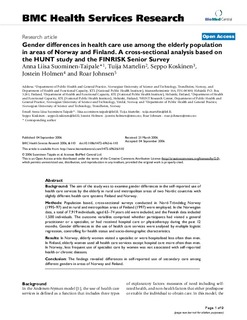Gender differences in health care use among the elderly population in areas of Norway and Finland. A cross-sectional analysis based on the HUNT study and the FINRISK Senior Survey
Journal article, Peer reviewed
Permanent lenke
http://hdl.handle.net/11250/301179Utgivelsesdato
2006Metadata
Vis full innførselSamlinger
Sammendrag
Background: The aim of the study was to examine gender differences in the self-reported use of
health care services by the elderly in rural and metropolitan areas of two Nordic countries with
slightly different health care systems: Finland and Norway.
Methods: Population based, cross-sectional surveys conducted in Nord-Tröndelag Norway
(1995–97) and in rural and metropolitan areas of Finland (1997) were employed. In the Norwegian
data, a total of 7,919 individuals, aged 65–74 years old were included, and the Finnish data included
1,500 individuals. The outcome variables comprised whether participants had visited a general
practitioner or a specialist, or had received hospital care or physiotherapy during the past 12
months. Gender differences in the use of health care services were analysed by multiple logistic
regression, controlling for health status and socio-demographic characteristics.
Results: In Norway, elderly women visited a specialist or were hospitalised less often than men.
In Finland, elderly women used all health care services except hospital care more often than men.
In Norway, less frequent use of specialist care by women was not associated with self-reported
health or chronic diseases.
Conclusion: The findings revealed differences in self-reported use of secondary care among
different genders in areas of Norway and Finland.
